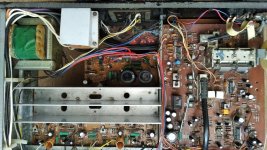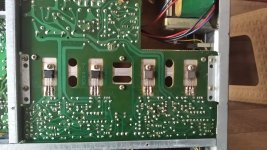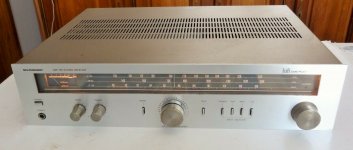hello!
I bought this amplifier ( hifi sound project 6691), I opened it to clean it and I found that the final transistors are changed. Or pair are TIP41c+TIP42C and other A768+C1826. I don't know what transistors were originally. I found out that this device is made by Philips and sold under several brands: Loewe, Schneider, Dueux. It doesn't sound bad, but I think it would be better in the initial configuration. Maybe anyone knows about this project, or if not, please tell me what would be the best transistor for this configuration. I don't know what voltage comes out of the transformer, the filtering capacitors of the source are 35V. I'm not an electronics specialist, I only have basic knowledge.
Thanks.
I bought this amplifier ( hifi sound project 6691), I opened it to clean it and I found that the final transistors are changed. Or pair are TIP41c+TIP42C and other A768+C1826. I don't know what transistors were originally. I found out that this device is made by Philips and sold under several brands: Loewe, Schneider, Dueux. It doesn't sound bad, but I think it would be better in the initial configuration. Maybe anyone knows about this project, or if not, please tell me what would be the best transistor for this configuration. I don't know what voltage comes out of the transformer, the filtering capacitors of the source are 35V. I'm not an electronics specialist, I only have basic knowledge.
Thanks.
Attachments
Unless you were going to change them out for modern TO-3P types for improved ruggedness I don’t think I would touch them. I don’t think there is enough rom to mount them properly without hogging out the PCB (not recommended).
The Sanken pair is probably original type, or at least closer to the originals. The TIPs are just a generic “it will work” type that are probably good enough for the application if you don’t hear a difference between channels. They are slower and lower gain at high current, but it likely does not matter here. A modern equivalent for the Sankens would be 2SA1725/2SC4511 but there isn’t any point in changing them unless they’re burnt out. They are nothing special. Fairchild used to offer the C5200 type in a TO-220, but they disappeared a year or two ago. Disappointing, because replacing underpowered TO-220 outputs was a perfect application. I would have used those, if they were still available. And I would not trust any that somebody is peddling on E-bay.
The Sanken pair is probably original type, or at least closer to the originals. The TIPs are just a generic “it will work” type that are probably good enough for the application if you don’t hear a difference between channels. They are slower and lower gain at high current, but it likely does not matter here. A modern equivalent for the Sankens would be 2SA1725/2SC4511 but there isn’t any point in changing them unless they’re burnt out. They are nothing special. Fairchild used to offer the C5200 type in a TO-220, but they disappeared a year or two ago. Disappointing, because replacing underpowered TO-220 outputs was a perfect application. I would have used those, if they were still available. And I would not trust any that somebody is peddling on E-bay.
Or maybe it sounded bad from new and this is an improvement?I think it would be better in the initial configuration.
That's usually a "built down to a price" product. The designer/company did not put their own name on it, but was contracted by a store-chain(s) to supply 30W+30W, 5 knobs, brushed faceplate, to sell at 129 guilders retail (ƒ50 out the factory door), and work at least 30 days.sold under several brands: Loewe, Schneider, Dueux.
Those old receivers would run more than 30 days, no problem. Unless you tried to run two pairs of speakers in parallel. Then you’d burn the output transistors out. Just a limitation of cheap TO-220’s and there isn’t really an easy way to upgrade it. The similar power NAD3020 used 2N3055’s - it’s just what it took to run 4 ohm loads semi-reliably. If it works now, use it like it is - but don’t use speakers with more than one woofer in the box or multiple pairs. My guess is thats what happened to at least one pair of the original outputs, requiring the TIPs. They are more rugged, but the gain can be very low because the spec is VERY loose. The TIPs will take 4 ohms on +/-28 or so volt supplies but if you get a pair with a gain of only 15 you’ll work the little TO-92 drivers to death supplying the base current. That’s why they are not really an “upgrade” - things are still only reliable with one pair of speakers.
Somebody here (indianajo?) said MJ15003 are better than than TIP41.
If you need to, just verify that I gave the right number, and do it.
But in normal use, if working, leave it alone.
And as informed above, use one pair of speakers at a time.
If you need to, just verify that I gave the right number, and do it.
But in normal use, if working, leave it alone.
And as informed above, use one pair of speakers at a time.
Yes, an MJ15003 is MUCH better than a TIP41. Getting a TO-3 to fit, however, is impossible here.
If you are thinking MJE15030, then maybe. Faster, yes. Higher gain yes. Not as rugged, less power handing at VCE=30. But maybe as much as the originals. If the transistors were actually bad, then you could consider the 15030/15031. I still wouldn’t change them unless they were shot and needed to.
If you are thinking MJE15030, then maybe. Faster, yes. Higher gain yes. Not as rugged, less power handing at VCE=30. But maybe as much as the originals. If the transistors were actually bad, then you could consider the 15030/15031. I still wouldn’t change them unless they were shot and needed to.
I haven't thought this right through, but there are a few oft-forgotten TO220 audio types like D44H11/D45H11 that should give a good account themselves here, since heatsink real estate is at a premium.
Please take your own advice before suggesting replacements: TIP41 first on the left; MJ15003 is the third one.Somebody here (indianajo?) said MJ15003 are better than than TIP41.
If you need to, just verify that I gave the right number, and do it.
Now look at the heatsink and PCB cutouts.
Imagine how to fit a TO3 transistor in space barely fitting TO220


Last edited:
Thanks to everyone for the answer.
I know it's a cheap amplifier but it sounds better than any Chinese class D module (I tried about 20 pieces, TDA, TPA, Tripath) and AB: LM3886, TDA7293, LM1875. It seems that he was lucky and worked for more than 30 days (at least 30 years).
There are differences between channels: one seems to hear some distortion (it can be subjective), but at high volume there is a difference in power. That's why I was thinking of replacing them. But, I see that your advice is that it is not worth replacing them and I think it will remain as it is.
I also saw on the Chinese market, many projects that use 2SC5200-Toshiba transistors. If there is a possibility to mount them, will I have an improvement in sound quality and power?
I know it's a cheap amplifier but it sounds better than any Chinese class D module (I tried about 20 pieces, TDA, TPA, Tripath) and AB: LM3886, TDA7293, LM1875. It seems that he was lucky and worked for more than 30 days (at least 30 years).
There are differences between channels: one seems to hear some distortion (it can be subjective), but at high volume there is a difference in power. That's why I was thinking of replacing them. But, I see that your advice is that it is not worth replacing them and I think it will remain as it is.
I also saw on the Chinese market, many projects that use 2SC5200-Toshiba transistors. If there is a possibility to mount them, will I have an improvement in sound quality and power?
These transistors, if they are the originals, are rated only 30 watts. This might explain why they blew up and were replaced... BD203/204 are similar, to-220 but 60 watts. And very cheap & still available from one of those big asian countries.A768+C1826
Is this hifi sound project 6691 the unit's designator? What is written onto the back plate?
Best regards!
Best regards!
The Chinese projects are quite likely to have poor parts, and fake transistors.
Buy old amplifiers and service if needed.
Much better results.
Buy old amplifiers and service if needed.
Much better results.
Then the Sanken are the originals, Philips used to source a lot from Japan for products made in India, Singapore, Hong Kong, and other locations in Asia.
Doubt "sound" will change and power will be same as before, because it comes from the same power supply, but new improved transistors (still TO220) can be way more robust and that´s an advantage.. If there is a possibility to mount them, will I have an improvement in sound quality and power?
Just enjoy your Receiver 🙂
There is a reason nobody uses those. The second breakdown limit kicks in around 12 volts and power handling drops like a stone. Faster than most do. At +/-30 volt rails, they hold up about as well as TO-92’s. The price you pay for speed. Kind of a shame, because they do everything else really well. Beta holds up FLAT to over 6 amps, no quasi-saturation, and of course fT through the roof. Run them down at +/-18 or so volts, and they are probably the best thing you could use. But then they are too much overkill for penny pinchers to choose them (But NO reason for DIY not to). They typically went with the D41 or D43 TO-202 versions for amps in the 10 watt range back in the day. Getting those is impossible these days unless you can find NTEs in stock (good luck) - when I see them they get the 44/45.I haven't thought this right through, but there are a few oft-forgotten TO220 audio types like D44H11/D45H11 that should give a good account themselves here, since heatsink real estate is at a premium.
If there IS any distortion difference between channels my money is on someone not setting the bias properly when they put in the TIPs. My experience with that type of amplifier is that TIPs work fine and don’t sound bad. 3MHz fT vs. 20, or gain of 100 vs. 50 mean nothing when it’s the rest of the amp that puts the ultimate limit on how low the distortion gets. Either the originals or the TIPs are somewhat delicate and you need to respect any “8 ohm minimum load“ rating. The power supply puts the limit on how much power you get - the transistors put the limit on whether it can be done safely and reliably. Distortion is low enough with run of the mill transistor types - you need to go to a refined circuit topology (which a price-point receiver will not have) to really notice a difference.Thanks to everyone for the answer.
I know it's a cheap amplifier but it sounds better than any Chinese class D module (I tried about 20 pieces, TDA, TPA, Tripath) and AB: LM3886, TDA7293, LM1875. It seems that he was lucky and worked for more than 30 days (at least 30 years).
There are differences between channels: one seems to hear some distortion (it can be subjective), but at high volume there is a difference in power. That's why I was thinking of replacing them. But, I see that your advice is that it is not worth replacing them and I think it will remain as it is.
I also saw on the Chinese market, many projects that use 2SC5200-Toshiba transistors. If there is a possibility to mount them, will I have an improvement in sound quality and power?
If you did put in C5200s you wouldn’t get any more power. But you could run 4 ohm loads to your hearts content without blowing them or the drivers. The bias would need to be adjusted - the larger die size would need a lower vbe to get the same idle current. Just leaving it is not an option because it WILL run hot. If there is no bias pot don’t even consider it unless you know what to change and how. I wouldn’t use Chinese fakes. They may not be any better than your TIP41/42. You might have a chance of getting the “N” package in there but it looks to me to be too tight. Modifying it is probably not a good idea for the inexperienced. If one came to ME to be fixed, and the owner fesses up to using 4 ohm speakers I would offer that option - but if not chosen or not the reason for failure I would put in whatever current production Sanken TO-220 pair designed for the purpose was actually in stock at a Digikey that day. If nothings available, then default to the TIP41/2 if they want it back quickly. In the past I probably would have used Toshiba TO-220 replacements as I kept them on hand, but the days of getting 14000 different fairly equivalent output transistor choices are long gone.
Looking at the picture, it would be quite easy to mount something bigger like 2sc5200: just put a piece of metal somewhat thicker than the circuitboard between the transistor and the heatsink. Now the size of the hole in the board does not matter anymore.
- Home
- Amplifiers
- Solid State
- Final transistor for vintage receiver


